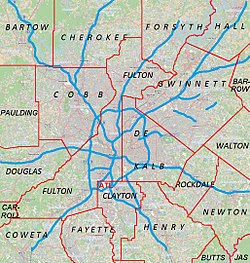Downtown Atlanta, Georgia
| Downtown Atlanta | |
|---|---|
| District | |

Part of the Downtown Atlanta skyline
|
|
| Location in Metro Atlanta | |
| Coordinates: 33°45′18″N 84°23′24″W / 33.75500°N 84.39000°WCoordinates: 33°45′18″N 84°23′24″W / 33.75500°N 84.39000°W | |
| Elevation | 225-320 m (738-1,050 ft) |
| Population (2010) | |
| • Total | 26,700 (approximately) |
| Time zone | EST (UTC-5) |
| • Summer (DST) | EDT (UTC-4) |
Downtown Atlanta is the central business district of Atlanta, Georgia, United States. The largest of the city's three commercial districts, Downtown is the location of many corporate or regional headquarters; city, county, state and federal government facilities; Georgia State University; sporting venues; and most of Atlanta's tourist attractions. Downtown measures approximately four square miles, and had 26,700 residents as of 2010. Similar to other central business districts in the U.S., Downtown has recently undergone a transformation that included the construction of new condos and lofts, renovation of historic buildings, and arrival of new residents and businesses.
Downtown is bound by North Avenue to the north, Boulevard to the east, Interstate 20 to the south, and Northside Drive to the west. This definition of Downtown Atlanta includes central areas like Five Points, the Hotel District and Fairlie-Poplar and outlying inner city neighborhoods such as SoNo and Castleberry Hill.
The Atlanta Downtown Improvement District (ADID) organization, though, defines a much smaller downtown area measuring just one and two tenths square miles. This area is roughly bound by North Avenue to the north, Piedmont Avenue and the Downtown Connector to the east, Martin Luther King Junior Drive, Courtland Street, and Edgewood Avenue to the south, and the railroad tracks to the west. This area only includes the core central business district neighborhoods of Fairlie-Poplar, Five Points, the Hotel District, Centennial Hill, and South Downtown.
The history of downtown began in 1826 with Wilson Lumpkin and Hamilton Fulton surveying a possible railroad route between Chattanooga, Tennessee, and Milledgeville, Georgia's capital at the time. In 1833, Lumpkin, who had become governor, requested that the state legislature charter three railroad lines. By 1836, the state-financed Western and Atlantic Railroad, linking the middle of Georgia to the other states north and west, was founded by the legislature and signed into law by Lumpkin. As a result, the town named Terminus was founded in 1837, named for the end of the railroad line. Terminus received a name change in 1842 when the town's 30 inhabitants voted to change the town's name to Marthasville, in honor of Governor Lumpkin's daughter.
...
Wikipedia

